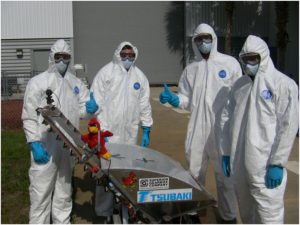 (Update: Watch video of the competition.)
(Update: Watch video of the competition.)
It doesn’t stack cubes of trash or watch old movie musicals. And it’s never going to develop a crush on some sleek and sexy EVE. But WALL-E’s real-world cousin may one day mine minerals on the moon’s surface—a critical function in establishing the first permanent lunar colonies.
Meet the Astro Robotic Tractor for Excavation—“ART-E” for short—Iowa State’s entry into NASA’s inaugural Lunabotics Mining Competition to be held May 27 and 28 at the Kennedy Space Center in Florida.
ART-E will be just one of about two dozen robots built from the ground up by collegiate engineering teams from across the nation vying to showcase to NASA engineers the most effective design for remotely excavating regolith, the fine sand-like matter covering the lunar surface. Entries will be judged on how much of the substance they can mine, store, transport, and then offload over a meter-high wall in a fifteen-minute period, with a ten-kilogram minimum to qualify.
NASA has given the teams a list of mission requirements, including speed, distance, and radio telemetry parameters for data and visuals back to the remote site—there can be no wires between operators and robots.
A novel approach
The Iowa State team—“LunaCY” (of course)—is composed of students from aerospace engineering assistant professor Stephen Holland’s multidisciplinary senior design class. The team, which includes mechanical, industrial, and materials engineering students, has been hard at work on ART-E since the start of the fall 2009 semester, putting the finishing touches on their creation up to the moment they loaded it into the van for the trip to Florida last weekend.
“We’ll be working in the same environment they train in before going to the moon,” says the project’s faculty advisor, Jim Heise, a lecturer in the Department of Mechanical Engineering. Yet while all the teams will face the same challenges, not all are tackling them in quite the same manner.
“We’re taking more of the ‘Toro’ approach,” Heise notes. “We’ll be using a snow blower-type device to collect the regolith and blow that into a hopper designed to hold 2½ cubic feet or better of regolith, which comes out close to 125 kilograms.”
Yet that’s not quite the case, says ME senior Zach Laws of State Center, Iowa, Team LunaCY’s student leader. “We’ve been calling it a snow blower,” he notes, “but a blower wouldn’t work on the moon. So it’s actually more of a snow thrower—it doesn’t depend on airflow or air movement at all. In that sense it’s lunar friendly.”
Once the hopper is full, Heise says, the student operators will run ART-E over to the collection bin, where they’ll activate the conveyer to empty the hopper. The team hopes to make two trips in the allotted fifteen minutes, “blowing” past the 10-kilogram minimum payload—and, if all works to plan, past their competition as well.
Leaping over early obstacles
But as with any new device—especially a one-off creation designed and executed under the added constraints of operability in the airless, low-gravity lunar environment—it hasn’t been easy getting ART-E clicking on all cylinders. After the initial welding of the robot’s aluminum chassis, Laws says, there was the challenge of the metal warping under the torch. This was later corrected with help from Howe’s Welding of Ames. Then, its first set of treads caused ART-E to sink in the sand. Finally, in early test runs, design flaws caused sand to leak out of the hopper as fast as the thrower could load it, rendering the conveyer useless.
Yet it’s challenges such as these that offer design students learning experiences they could never get out of a textbook or lecture. And, working with other young engineers across disciplinary lines, they sharpen and broaden their skills, getting a foretaste of the more demanding creative environments they’ll encounter in the workplace.
Take team member Steve Lischer, for example. In the absence of an electrical or computer engineer on the team, the senior ME student from Urbandale, Iowa, took up the challenge of tackling the project’s electronics and robotics on his own—with a little help from his friends.
“I’ve got a few friends who deal with robotics,” Lischer says, “and a friend who transferred out of EE and is pretty good with electronics I’ve been consulting to get all this stuff made.
“I’m really interested in robotics,” adds Lischer, who has worked with ECpE robotics expert, Assistant Professor Alex Stoytchev. “This gets me a little more insight into the electro-mechanical side of things. And even programming: how do I design an electronic system so it interacts with the software? So it’s given me a broader perspective on that, more hands on.”
‘A different side of engineering’
That broader perspective benefits even aspiring industrial engineers such as Jason Rask of St. Charles, Illinois, who, despite the project’s one-off design and construction, feels that understanding the robot’s development from prototype to finished product can make for better-informed decisions on manufacturing, should the device go into production.
“When you try to go back and figure out how to manufacture something like this—materials selection, how many you’re going to make—there’s a lot of different things that go into it,” says Rask. “It’s kind of difficult to assume anything about its manufacturability.
“It’s a different side of engineering that I’ve never really been taught,” he adds. “I still don’t understand electronics, but I’ve learned more of the mechanical side. It’s kind of cool just to see how everything works.”
Competition results will be posted at this site as soon as they are available.
